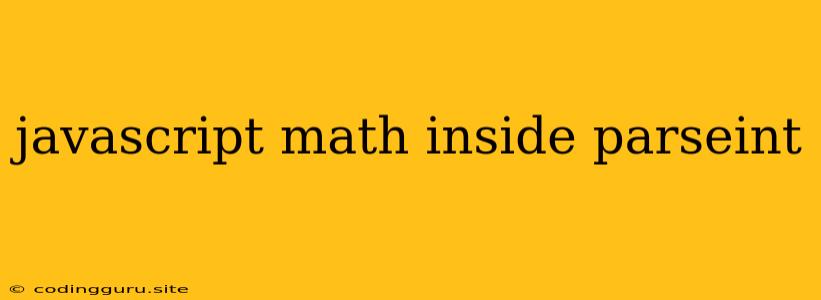JavaScript: Parsing Integers with Math
Have you ever wondered how to use JavaScript's parseInt function effectively when you need to manipulate numerical values? One common scenario involves incorporating mathematical operations within the parsing process. This article will guide you through the intricacies of parseInt and delve into how you can leverage its power alongside basic mathematical expressions.
Understanding parseInt
Before diving into the specifics of combining math and parseInt, let's refresh our understanding of this essential JavaScript function. parseInt is a powerful tool that converts a string into an integer. It takes two arguments:
- The string to be parsed: This could be a string representation of a number, like "123", or a string containing characters that might represent a number.
- The radix (optional): This specifies the base of the number system. If you don't provide a radix,
parseIntwill attempt to guess it based on the string's prefix. For example, if the string starts with "0x",parseIntwill assume it's a hexadecimal number.
Example 1:
let numString = "100";
let numInteger = parseInt(numString);
console.log(numInteger); // Output: 100
parseInt with Mathematical Operations
The real power of parseInt lies in its ability to work in conjunction with basic mathematical operations. This allows you to perform calculations directly within the parsing process.
Example 2:
let stringValue = "150";
let calculatedValue = parseInt(stringValue) + 50;
console.log(calculatedValue); // Output: 200
In this example, we first parse the string "150" into an integer using parseInt. We then add 50 to the resulting integer, demonstrating how to seamlessly combine math and parsing.
parseInt and String Manipulation
Beyond simple addition, parseInt can be combined with other string manipulation techniques. For instance, you can use parseInt to extract a specific numerical part from a string and perform calculations on it.
Example 3:
let priceString = "$19.99";
let priceInteger = parseInt(priceString.substring(1));
console.log(priceInteger); // Output: 19
Here, we remove the dollar sign ($) from the priceString using substring and then use parseInt to convert the remaining part into an integer.
parseInt and Error Handling
It's crucial to be aware that parseInt can sometimes return unexpected results or errors. For instance, if the string doesn't represent a valid number, parseInt will return NaN (Not a Number).
Example 4:
let invalidString = "abc";
let invalidInteger = parseInt(invalidString);
console.log(invalidInteger); // Output: NaN
Therefore, it's generally a good practice to implement error handling mechanisms to validate input strings before using parseInt.
Conclusion
Combining JavaScript's parseInt function with basic mathematical operations opens up a world of possibilities for data manipulation and calculations. By understanding how these two tools interact, you can efficiently extract numeric values from strings and incorporate them into your JavaScript code. Remember to handle potential errors and validate your input strings to ensure reliable and accurate results.
